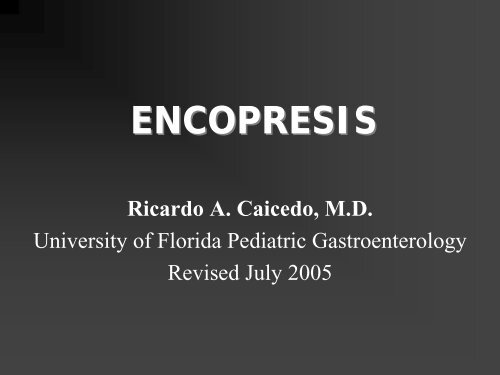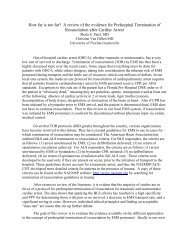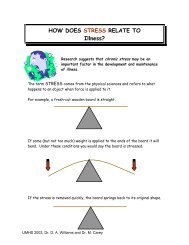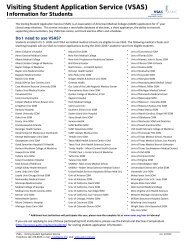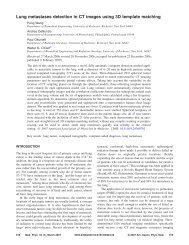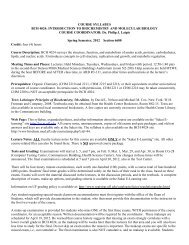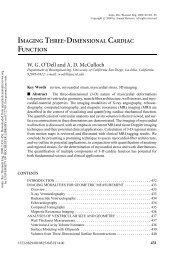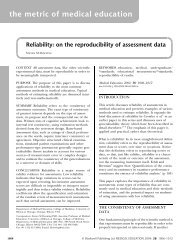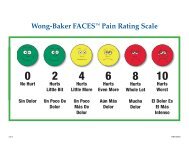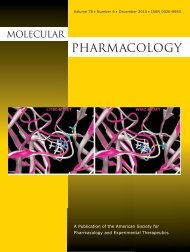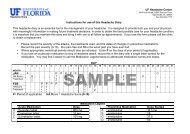TOILET TRAINING and ENCOPRESIS - Pediatric Residency Program
TOILET TRAINING and ENCOPRESIS - Pediatric Residency Program
TOILET TRAINING and ENCOPRESIS - Pediatric Residency Program
Create successful ePaper yourself
Turn your PDF publications into a flip-book with our unique Google optimized e-Paper software.
<strong>ENCOPRESIS</strong>• Introduction– Definition– Classification• Elements– Constipation– Stool Retention– Incontinence– Development <strong>and</strong> Behavior• Toilet training• Other potentiators• Evaluation• Management
<strong>ENCOPRESIS</strong> 1• Repeated passage of feces into inappropriateplaces such as clothing or floor•Age >4 years – chronological or mental• Involuntary or intentional• Not due to an organic disorder or medication• At least once a month for > 3 months1. American Psychiatric Association. Diagnostic <strong>and</strong> Statistical Manual of Mental Disorders 4 th ed. (DSM-IV).Washington, DC: American Psychiatric Association; 1994:106-110.
<strong>ENCOPRESIS</strong>• Affects 1-3 % of children• Boys > girls (estimated at 4-6:1) 2• Most accidents occur later in day (3-7 PM) 2• Primary (continuous): child has nevercompleted toilet training for stool• Secondary (discontinuous): toilet trainedchild regresses to incontinence2. Levine MD. Encopresis. In: Levine MD, Carey WB, Crocker AC, eds. Developmental-Behavioral <strong>Pediatric</strong>s.Philadelphia: Saunders; 1983: 586-95.
<strong>ENCOPRESIS</strong>• Retentive (80-95%): involves– Constipation– Stool retention– Overflow incontinence• Nonretentive or “solitary”(5-20%) 3 :– No constipation or overflow incontinence– Stool toileting refusal/resistance/”phobia”– Often manifestation of emotional disturbance• Virtually all children with encopresis retainstools at least intermittently 43. Kuhn BR et al. Am Family Physician 1999; 59(8): 312-17.4. Levine MD. Pediatr Rev. 1981; 2:285.
EPIDEMIOLOGY 5INCIDENCEOverall children 1.5 %School childrenaged 6-121.5-7.5% 134 y/o 2.8 %5 y/o 2.2 %6 y/o 1.9 %7 y/o 1.5 %Gen Peds clinics 3.0 %Child Ψoutpts. 5.7 %Child Ψ inpts. 8.0 %Peds GI clinics 25 %• Incidence & prevalencedecrease with age• More prevalent in boys• Prevalence reverses inelderly• 16% of affectedchildren have oneaffected parent• All socioeconomicclasses5. Boon FL <strong>and</strong> Singh NN. Behav Modif 1991; 15(3): 355-71.13. McGrath ML et al., J Pediatr Psychol 2000; 25(4): 225-54.
ELEMENTS of <strong>ENCOPRESIS</strong>• Constipation• Stool retention• Incontinence• Development <strong>and</strong> Behavior– Toilet training– Other risk factors
CONSTIPATIONDifferential Diagnosis• FUNCTIONAL (>95%)• Intestinal– Hirschprung’s disease– Celiac disease– Anal stricture/stenosis– Anterior dislocation ofthe anus– Imperforate anus– Meconium ileusequivalent (CF)– Pseudo-obstruction• Metabolic– Hypothyroidism– Hypokalemia– Hypercalcemia– Dehydration• Drugs– Opiates– Antidepressants– Anticholinergics– Lead poisoning• Neuromuscular– Spinal cord lesion– Pre-sacral mass – Hypotonia– CP
CONSTIPATIONEvaluation• History–Onset– Stool character– Encopresis– Toilet training– Stool size– GI sx (abd pain, N/V)– Diet/appetite–Growth– Family Hx• Physical– Abdominal distention– Palpable stool masses– Anal tone– Stool in vault– Neurologic• Laboratory• Barium enema• Rectal biopsy• Anorectal manometry• Blood tests
CONSTIPATIONRed Flags for Organic Causes• Failure to thrive• No withholding• No soiling• Extraintestinalsymptoms• No response toconventionaltreatment• Flat buttocks• Spinal dimple/tuft• Patulous anus• Abdominal distention• Tight, empty rectum• Gush of liquid stool/air fromrectum upon withdrawal• Occult blood in stool• Absent anal wink• Decreased LE tone/strength
STOOL RETENTIONToiletavoidancePainfuldefecationAnal fissures orhemorrhoidsIncreasingretentionIncreased colonicwater absorptionLarger/harderstoolsReduced sensoryfeedbackStretched rectal wallAltered defecationreflexesParadoxical analsphincter relaxationStool incontinence
STOOLRETENTIONUniv. of Iowa HSC
INCONTINENCE• In presence of large fecal mass– Anal sphincter relaxes• In response to arrival of morestools OR• When child tries to pass gas OR• When muscles used to withholdare used in other activities– Stool, usually soft or liquid,leaks out around impaction
PHYSIOLOGICAL CORRELATES 6• Contractile status of anal sphincter• Investigated with multiple modalities– Rectal balloon defecation test– Anal electromyography– Anorectal manometry• Conflicting reports• Primary disorder vs. Secondary to chronicstool retention6. Mikkelsen EJ. J Am Acad Child Adol Psych 2001; 40(10): 476-501.
FUNCTIONAL CONSTIPATIONPathogenetic Model 10Carlo Di Lorenzo, MD10. Di Lorenzo C. Gastroenterology Clinics 2001: 30(1).
DEVELOPMENTAL MODELStages in Pathogenesis of Encopresis 2• Stage I– Infancy <strong>and</strong> toddler years– Early experience <strong>and</strong> constitutional predisposition• Stage II– 3-5 years old– Toilet training <strong>and</strong> early autonomy• Stage III– Early school years– Function in new environments2. Levine MD. Encopresis. In: Levine MD, Carey WB, Crocker AC, eds. Developmental-Behavioral<strong>Pediatric</strong>s. Philadelphia: Saunders; 1983: 586-95.Melvin D. Levine, MD
DEVELOPMENTAL MODEL 2• Multiple risk factors interplay with oneanother• Presence of multiple risk factors increaseschild’s vulnerability to developingencopresis• Accumulation of risk factorsPOTENTIATES the problem• Each of the 3 stages has its own set ofinherent potentiators of encopresis2. Levine MD. Encopresis. In: Levine MD, Carey WB, Crocker AC, eds. Developmental-Behavioral<strong>Pediatric</strong>s. Philadelphia: Saunders; 1983: 586-95.
Stage 1Infancy <strong>and</strong> toddler years• Simple constipation• Early colonic inertia• Congenital anorectal problem• Other anorectal conditions• Parental overreaction• Coercive interventions→ “the analstamp”
Stage 2Training & early autonomy• Anxiety over sitting on toilet• Magical thinking <strong>and</strong> fears– Falling in– Toilet flooding– Monsters <strong>and</strong> snakes• Overly coercive or permissive training• Other areas of autonomy conflict• Painful or difficult defecation
<strong>TOILET</strong> <strong>TRAINING</strong>• Bowel control– No longer involuntary leakage of stool fromrectum– Not categorized as daytime or nighttime control• Most U.S. children fully trained between24-48 months of age• No universal timeline for process– Two divergent approaches have been widelyadvocated
<strong>TOILET</strong> <strong>TRAINING</strong>Approaches• Structured-behavioral– Azrin & Foxx, Toilet Training in Less than a Day (1974)– Endpoint-oriented– Teaching/eliciting chain of independent toileting behaviors• Child-oriented– Brazelton (1962)– Gradual, developmental– Response to child’s signals oftoileting readiness– Favored by AAP <strong>and</strong> more widely usedT. Berry Brazelton, MD
AAP GUIDELINES 7• Suggest parents– avoid forcing or pushing child into training– look for signs of readiness for mature toileting– seek support & guidance from healthcare provider• No universal right age to begin or deadline tocomplete training• Emphasize that toilet training is keydevelopmental milestone– Acknowledge roles of parents, caretakers, <strong>and</strong>daycare providers7. Stadtler, AC, Gorski PA, Brazelton TB. <strong>Pediatric</strong>s 1999; 103(6).
SIGNS OF READINESS 7,8• Imitates parents’ behavior• Expresses interest in toileting• Begins to put things where they belong• Indicates when wetting or soiling• Walks well• Can sit down on potty chair• Able to undress <strong>and</strong> dress• Can communicate need to “go”• Can follow one <strong>and</strong> two-step comm<strong>and</strong>s• Demonstrates independence by saying “no”• Desires to please based on positive relationship w/caregiver7. Stadtler, AC, Gorski PA, Brazelton TB. <strong>Pediatric</strong>s 1999; 103(6). 8. Michel RS. Ped Rev 1999; 20(7): 240-45.8. Michel RS. Ped Rev 1999; 20(7): 240-45.
<strong>TOILET</strong>ING REFUSAL8. Michel RS. Ped Rev 1999; 20(7): 240-45.
Stage 3Extramural function• Avoidance of school bathrooms• Prolonged gastroenteritis• Dietary issues– Lactose intolerance– Overconsumption of milk <strong>and</strong> chocolate• Attention deficit <strong>and</strong> task impersistence• Frenetic lifestyles• Psychosocial stressors
CO-MORBIDASSOCIATIONS 5,11• Low self-esteem• Social withdrawal• Depression• Anxiety• “Neurosis”• Learning disabilities• Attentional dysfunction• ADHD• Conduct disorder• Child abuse (victims)• Enuresis5. Boon FL <strong>and</strong> Singh NN. Behav Modif 1991; 15(3): 355-71.11. Johnston BD <strong>and</strong> Wright JA. Dev Behav <strong>Pediatric</strong>s 1993; 14(6): 381-84.
<strong>ENCOPRESIS</strong> <strong>and</strong> ADHD 11• Child with ADHD more likely to have encopresis than normal• Task impersistence (Levine): child seldom finishes what hestarts, including defecation• Deficient self-monitoring– Less responsive to rectal distention– Less likely to act on physical cues• Poor prioritization• Poor reinforceability• Suggested association, but few studies– 23% of encopretic children scored >98 th %ile on hyperactivitysubscale of Child Behavior Checklist– 30% of untreated encopretics scored in clin. sig. range of hyperactivityon Conner’s scale• Constipation is side effect of stimulants <strong>and</strong> TCAs11. Johnston BD <strong>and</strong> Wright JA. Dev Behav <strong>Pediatric</strong>s 1993; 14(6): 381-84.
<strong>ENCOPRESIS</strong> <strong>and</strong> Child Abuse 12• Significant physical abuse as punishmentfor soiling• Victims of sexual abuse– Anal penetration <strong>and</strong> subsequent trauma– Damage to anal sphincter– Painful defecation <strong>and</strong> retention cycle12. Buttross S, Pediatr Ann 1999; 28(5):317-21.
<strong>ENCOPRESIS</strong> <strong>and</strong> ENURESIS• Distended rectum can compromise bladderfunction 2– Usually causes dribbling– Treatment of stool retention usually treats this• 15-25% of children with enuresis also haveencopresis 14• Prevalence of enuresis in children with encopresisvaries among studies 2• Obstructive uropathy secondary to obstipation• In girls, UTI secondary to soiling of perineum2. Levine MD. Encopresis. In: Levine MD, Carey WB, Crocker AC, eds. Developmental-Behavioral <strong>Pediatric</strong>s.Philadelphia: Saunders; 1983: 586-95.14. Issenman RM et al., <strong>Pediatric</strong>s 1999; 103 (6): 1346-52.
MANAGEMENT• Initial counseling• Initial cleanout• Maintenance therapy– Lessen stool retention– Restore regular bowel habits– Maintain soft stools– Restore neuromuscular function– Heal emotional scars• Follow-up
PATIENT EDUCATION2. Levine MD. Encopresis. In: Levine MD, Carey WB, Crocker AC, eds. Developmental-Behavioral <strong>Pediatric</strong>s.Philadelphia: Saunders; 1983: 586-95.
TREATMENT• Cleanout– Cycles of enemas, suppository, laxative– Inpatient if severe or complicated• Maintenance– Regular toileting routine – same times each day– Dietary fiber <strong>and</strong> increased water intake– Laxatives• Osmotic: M.o.M., lactulose• Stimulant – bisacodyl, senna– Stool softeners – Colace• Continue for prolonged period (> 6 months)
REFRACTORY <strong>ENCOPRESIS</strong>• Enlist help of parents <strong>and</strong> teachers• Behavioral counseling• Biofeedback programs• Psychological or psychiatric referral– Nonretentive encopresis resistant to treatment– Family psychopathology– Parental sabotage of treatment• Requires pediatric tenacity


